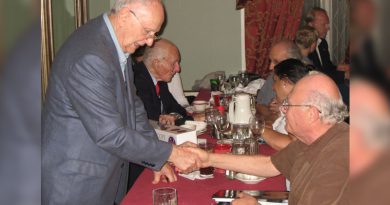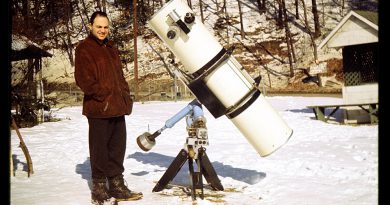Subject: 10715 NAGLER (1983 RL4)

We’d like to share with you this nice letter Al received from Roger Harvey recently.
From: Roger Harvey
To: Al Nagler
Subject: 10715 NAGLER (1983 RL4)
Hi Al,
We first met at the Wildacres Retreat, North Carolina mountains, this past April. Despite our lengthy conversation that I will always remember, you never mentioned that you were honored with asteroid 10715 Nagler (1983 RL4).
As luck would have it, my primary effort in amateur astronomy the past 40+ years has been visually identifying asteroids by their position, magnitude, and motion against the background star field.
My observing session for August 16, 2017 happened to include 10715. I saw it at 3:54, 4:32, and 6:28 UT retrograding southwestward in Aquarius at magnitude 16.3. This was ~0.5 magnitude fainter than advertised…not uncommon with higher numbered asteroids. In doing so it was my 5900th asteroid.
My scope is a Lockwood 32” f/4 which (of course!) I couple with your Paracorr Type 1. The 5.5 mm eyepiece yields 676X which is my usual choice. Several times I’ve had to go to 1352X for very faint targets requiring a darker field. Obviously such an effort would be impossible without the excellent optical train above.
Again, it was great speaking with you on the phone today! I am so glad you got a kick out of your asteroid actually being seen by a human (read eyeball, not CCD) (:>). Your joy made my day as well.
Roger Harvey
Asteroid 10715 Nagler was at opposition in the last days of August and will make perihelion on January 2, 2018. If anyone reading this cares to image the field around this asteroid over a period to show its motion, post it on social media with the tag #televue40 and we’ll repost it in our feeds.

About Roger Harvey
We were impressed with Roger’s dedication to asteroid observing and asked him for the details on how this interest came about.
In 1973 I was using a 10-inch reflector I made in high school. This worked well enough for asteroids brighter than 14th magnitude. A few years later I upgraded to a Coulter 20-inch scope, making the tube, fork mount, equatorial drive etc. myself.
Using this scope I had passed the 2,600 mark of finding different asteroids. Like other asteroid hunters my reward from the hours of planning, chart making, and time at the eyepiece is not from fame (if any) or financial reward or seeing a particular asteroid that no one has ever seen before, but simply the thrill of the hunt. It is a special kind of observing that few (now fewer with CCDs) partake.
Spring of 1984 I upgraded to the Coulter 29-inch mirror and continued my effort seeking asteroids brighter than 16th magnitude. Finally in March 2017 I upgraded again to a Lockwood 32-inch f/4 scope which I plan to use for the duration. With it I recently passed the 6,000 mark.
Spending all the hours in this effort of finding asteroids, past and future, I blame on my introduction to them by Dr. J. U. Gunter when he spoke to the Charlotte Amateur Astronomers Club in 1973.
One rarely if ever gets a chance to say “Thank you” to someone who in retrospect has such an effect on your life. February 26, 1989 I had such a chance when Dr. Gunter accepted my invitation and drove down from Durham, NC. We observed (2136) JUGTA, named for him and his famous Tonight’s Asteroids publication. The asteroid was only 15.3 magnitude and forever beyond his home made 8-inch scope. I watched him stand on the ladder, silhouetted against the sky through the open shutter box, observing for 30-minutes as his asteroid moved against the back drop of stars.
For years Dr. Gunter had promoted asteroids for amateur astronomers around the world. Now I was lucky enough to thank him from all of us who had benefited from his generosity of time and effort. This was certainly my most rewarding evening observing asteroids, and I know for Jay his as well.
We did a little research on our own on Roger and found this citation for asteroid 4278 Harvey on the International Astronomical Union’s Minor Planet Center website:
(4278) Harvey = 1982 SF
Discovered at Anderson Mesa on 1982-09-22 by E. Bowell.
Named in honor of G. Roger Harvey, instructor in astronomy at the University of North Carolina in Charlotte. Using handcrafted Newtonian reflectors of up to 74-cm aperture, Harvey has visually observed more than 2600 different minor planets, far surpassing previous efforts. His observations have at times proved scientifically valuable for determining rotation periods and identifying wayward objects. Name suggested and citation provided by J. U. Gunter, who sparked Harvey’s interest in minor planets; name endorsed by B. G. Marsden. [Ref: Minor Planet Circ. 16593]
So our congratulations to Roger for evenings well spent!
- More about Asteroid 10715 Nagler on our site (mobile version)
- Obituary for Dr. J. U. Gunter in the Minor Planet Bulletin discusses his decades-long asteroid efforts and how they inspired others to follow suit.
- Tele Vue’s Paracorr Type-2 makes color-free coma (star elongation) corrections to fast Newtonians (mobile version).
- Read Paracorr’s role in the New Dobsonian Revolution (PDF) article from Astronomy Magazine
- Paracorr Gallery on flickr.com
Did you observe, sketch, or image with Tele Vue gear? We’ll like your social media post on that if you tag it #televue and the gear used. Example:
#televue #tv85 #ethos #jupiter
Do you want your Tele Vue images re-posted on Tele Vue Optics’ Social Media accounts? Use this hashtag for consideration:




